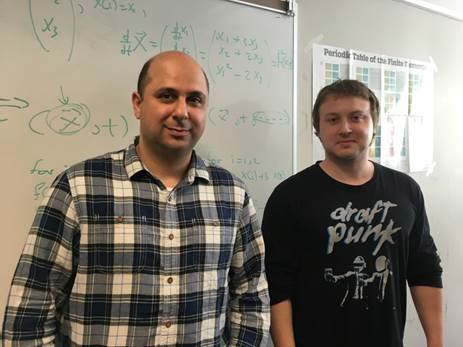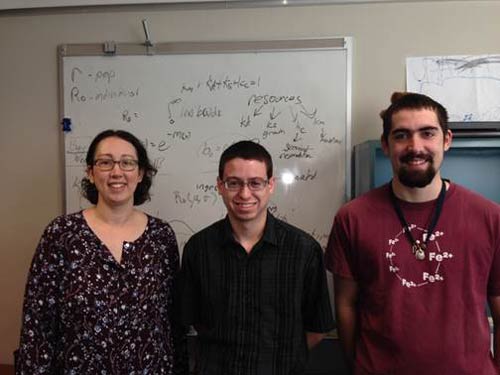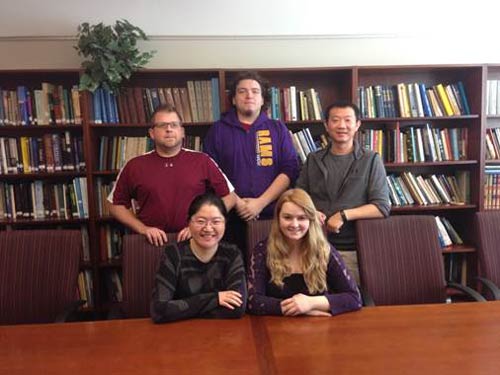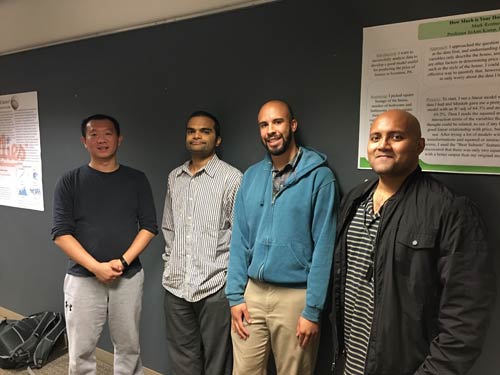Student Projects
Spring 2016 Graduate Assistant Research Projects
Dr. Andreas Aristotelous and his student

Graduate student Ben Plumridge (pictured right) is working with Dr. Andreas Aristotelous (pictured left) on a project in which the aim is to devise a model that simulates the dorsal closure process, a stage of Drosophila morphogenesis. We are developing our model, based on relevant previous work. We represent the apical side of the amnioseroa (a cell monolayer wound like region on the surface of the embryo) through polygonal two dimensional representations of each cell with forces acting on their edges and nodes. Those forces are being regulated by the action of actin and myosin. The model is granular enough so various sub regions can be studied to the level of individual cell. Various equations describing the evolution of the forces generated by the action of the actomyosin network which itself is biochemically driven will be tested as soon as the geometric and mechanical components of our model are finished.
Ben has been partially supported by Dr Aristotelous' GA grant for 2016-2017.
Dr. Allison Kolpas and her students

Graduate Student Lane D'Alessandro (pictured in the middle), with the help of Adam Helker, a B.S. mathematics-computational major (pictured right), are working with Dr. Allison Kolpas (pictured left) developing an optimization model to understand the evolution of reproductive rate and senescence in species such as freshwater snails where resource allocation is highly plastic.
Dr. Chuan Li and his students

Graduate student Xiaojuan (Cathy) Yu (pictured in front row left) is working on two closely-related research projects with Dr. Chuan Li (pictured in back row right): “A high-performance parallel computing bio-molecular surface generator” and “Developing a fast Alternate Direction Implicit (ADI) method for solving parabolic interface problems in Biophysics.” These two projects are aimed at delivering a highly efficient and robust software package for constructing the molecular surface and calculating electrostatic potentials and energies.
Graduate student Jamie Funk (pictured in back row left) is working with Dr. Chuan Li on a project entitled “A mathematical model for the interactions between Plasmodium falciparum malaria parasite and host immune response.” Given his background in biology and medicine, Jamie is helping us to understand the interactions between the immune system and antibodies and their responses to the parasites.

Shoumik Chatterjee is working with Dr. Li to compose a Matlab tutorial. The tutorial focuses on providing first-time users a hands-on experience how access and use the pre-installed Matlab on RamCloud server RamCloud.wcupa.edu via CitrixReceiver. Moreover, Matlab windows, basic Matlab functionalities for numerical calculations, as well as most commonly used commands for 2D and 3D plotting, are described in the tutorial.
Quazi Haque is participating in a project to compose a LaTex tutorial. This tutorial not only describes how to write mathematical manuscripts using TextMaker and MikeTex, but also describes how to write scientific presentation slides using the Beamer package.
James Scott is interested in learning how to perform scientific computing, especially the parallel computing, on a computing cluster. He is helping Dr. Li apply for computational time and resource on the Pittsburgh Supercomputing Center (PSC). Upon granted, we will utilize the PSC in the course of Scientific Computing MAT543 this semester. We will document our experience and provide it to faculties who will teach similar courses in the future.
Dr. Mark McKibben and his students
Graduate students Mike Clemons,Chris Hegeland, and Michael Hurst are working jointly with Dr. Mark McKibben on writing case-study driven chapters in queueing theory, applied game theory, and numerical differential equations, respectively. This work will form the basis for chapters devoted to these topics in an upcoming industrial mathematics compendium.
